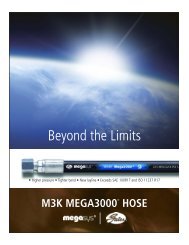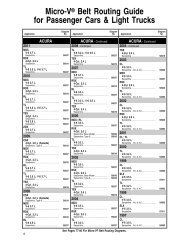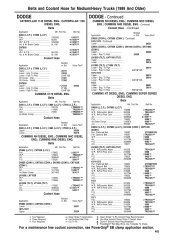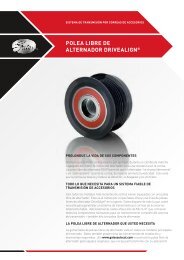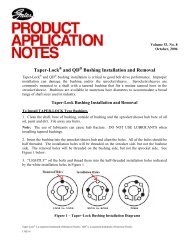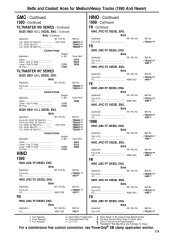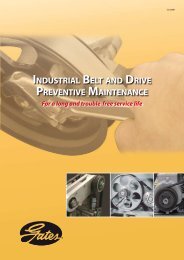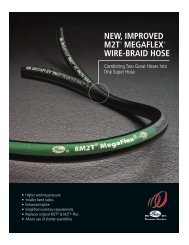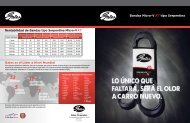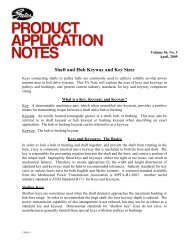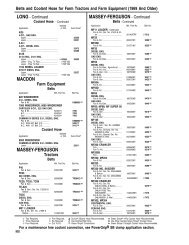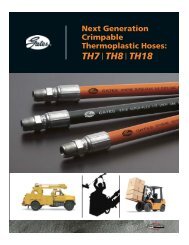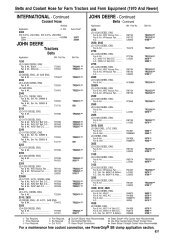PowerGrip® GT® Belt Drives
PowerGrip® GT® Belt Drives
PowerGrip® GT® Belt Drives
You also want an ePaper? Increase the reach of your titles
YUMPU automatically turns print PDFs into web optimized ePapers that Google loves.
Synchronous <strong>Belt</strong> <strong>Drives</strong> – Engineering<br />
VI. <strong>Belt</strong> Pull — continued<br />
A. Motion Transfer <strong>Drives</strong><br />
Motion transfer drives, by definition do not carry a<br />
significant torque load. As a result, the belt pull is<br />
dependent only on the installation tension. Because<br />
installation tensions are provided on a per-strand<br />
basis, the total belt pull can be calculated by vector<br />
addition.<br />
B. Power Transmission <strong>Drives</strong><br />
Torque load and installation tension both influence<br />
the belt pull in power transmission drives. The level<br />
of installation tension influences the dynamic<br />
tension ratio of the belt spans. The tension ratio is<br />
defined as the tight side (or load carrying) tension<br />
TT divided by the slack side (or non-load carrying)<br />
tension TS. Synchronous belt drives are generally<br />
pre-tensioned to operate dynamically at a 5:1<br />
tension ratio in order to provide the best possible<br />
performance. After running for a short time, this<br />
ratio is known to increase somewhat as the belt runs<br />
in and seats with the sprockets reducing tension.<br />
Formula 6 and Formula 7 can be used to calculate<br />
the estimated TT and TS tensions assuming a 5:1<br />
tension ratio. TT and TS tensions can then be<br />
summed into a single vector force and direction.<br />
Formula 6<br />
T T = 2.5(Q) , lb.<br />
Pd<br />
Formula 7<br />
T S = 0.5(Q) , lb.<br />
Pd<br />
Where: T T = Tight side tension, pounds<br />
TS = Slack side tension, pounds<br />
Q = Torque Load, pound inches<br />
Pd = Pitch diameter, inches<br />
If both direction and magnitude of belt pull are<br />
required, the vector sum of TT and T S can be found<br />
by graphical vector addition as shown in Fig. 9. TT<br />
and T S vectors are drawn parallel to the tight and<br />
slack sides at a convenient scale. The magnitude<br />
and direction of the resultant vector, or belt pull, can<br />
then be measured graphically. The same<br />
procedures can be used for finding belt pull on the<br />
driveN shaft. This method can also be used for<br />
drives using three or more sprockets or idlers.<br />
Figure 9<br />
Figure 10<br />
For two sprocket drives, belt pull on the driveR and<br />
driveN shafts is equal but opposite in direction. For<br />
drives using idlers, both magnitude and direction<br />
may be different. If only the magnitude of the belt<br />
pull is needed in a two sprocket drive, use the<br />
following procedure.<br />
1. Add TT and TS<br />
2. Using the value of (D-d)/C for the drive, find the<br />
vector sum correction factor using Fig. 10. Or,<br />
use the known arc of contact on the small<br />
sprocket where:<br />
D = large diameter<br />
d = small diameter<br />
C = center distance<br />
3. Multiply the sum of TT and TS by the vector sum<br />
correction factor to find the vector sum, or belt<br />
pull.<br />
For drives using idlers, either use the graphical<br />
method or contact Gates Application<br />
Engineering for assistance.<br />
C. Registration <strong>Drives</strong><br />
Synchronous belt drives used for purposes of<br />
accurate registration or synchronization generally<br />
require the use of higher than normal installation<br />
tensions (see section III. <strong>Belt</strong> Tensioning). These<br />
drives will operate with higher belt pulls than<br />
normal power transmission drives. <strong>Belt</strong> pull values<br />
for these types of applications should be verified<br />
experimentally, but can be estimated by adding the<br />
installation tension in each belt span vectorially.<br />
For guidance in calculating bearing loads, see Bearing Load Calculations on page 86.<br />
The World’s Most Trusted Name in <strong>Belt</strong>s, Hose & Hydraulics.<br />
55



